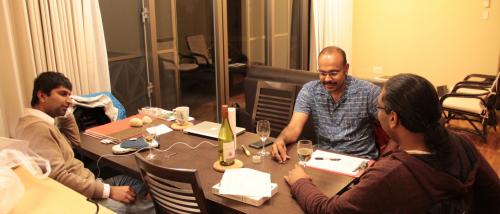Venkadesan and collaborators win HSFP research grant
The international Human Science Frontier Program awarded a Young Investigator research grant to NCBS principal investigator Madhusudhan Venkadesan and his collaborators, Mahesh Bandi (Okinawa Institute of Science and Technology Graduate University, Japan) and Shreyas Mandre (School of Engineering, Brown University, USA) last month. They received the three-year grant (of $350,000 per year), for a project titled "Foot in Motion: Materials, Mechanics and Control" which proposes to study how the human foot helps in stable, energy efficient locomotion.
Locomotion is a well-studied topic: but mathematical models and robots often treat the foot as a peg or a rigid, extended structure. Such feet would transmit every bump on the road – an uncomfortable ride to say the least. But the human foot is neither a peg nor is it rigid: it is soft and flexes. The human foot is also fairly complex, something models have not been able to incorporate: between both feet, fifty-two bones and numerous joints, muscles, tendons and ligaments work incessantly to keep the body on the move, be it walking or running. But there's more to the foot than these physical parts. Studies show that the arch of the foot plays a critical role in energy efficiency by elastically storing almost a fifth of the total energy turnover while running. But energetics is just one aspect. The Foot in Motion team proposes that stability is an equally important functional demand on the foot. “What we are proposing is that the foot does the right thing at the right time, and a lot of it is because of its clever, evolved structure. When you land, it is soft, smoothing out ground unevenness and storing elastic energy; when you lift off, it stiffens up and rapidly returns the elastic energy,” says the principal applicant of the Foot in Motion project Venkadesan, who studies morphology and control in animals and machines at NCBS. “We are proposing that the human foot is very multi-functional and a lot of it is because of the basic structure of the foot,” says Venkadesan. The multi-functional role they refer to is how the foot helps both in stability and efficient energetics. The nervous system also plays an important role and Venkadesan, Bandi and Mandre hypothesize that the neural system controls the geometry and mechanical properties of the foot in response to the type of terrain one runs on; giving greater emphasis to energetics on flat ground and to stability on uneven ground.
To test this hypothesis, Venkadesan and his colleagues have to measure the 3D forces under the entire foot. There is currently no device that can do this effectively, and the first stage of the three-year project will involve creating one from scratch. Venkadesan and his colleagues, experimental physicist Bandi and applied mathematician Mandre will work on the experimental and theoretical aspects to develop this sensor. Once complete, they will bring the sensor to India and test it by making volunteers run on it. At the same time, the scientists will use cameras to record the motion of the foot in 3D, and also measure neural control using a method called electromyography, which records electrical activity generated by foot muscles in response to neural signals.

(From left to right): Shreyas Mandre, Madhusudhan Venkadesan and Mahesh Bandi discussing the project at Okinawa, Japan. Photo by Soumya James.
The scientists will compare these experimental data with mathematical models, and with a foot they design, optimized for both stability and energy. To complete the picture and understand the mechanism of the foot better, the team also plans to trace the evolutionary trajectory of the foot's morphology. Venkadesan and his team will obtain skeletal reconstructions of chimpanzee feet as well as many ancestral and modern human feet. "We will add instrumentation - springs and little motors - to mimic what we think are the necessary elements for locomotion," he says. "This may tell us how morphology helps function, and identify the bounds of performance of ancestral feet and our modern foot." The project is time and labour-intensive and all three scientists are looking to hire post-doctoral candidates as well as graduate students trained and interested in biomechanics, control theory and elasticity to work with them on the Foot in Motion project.
Venkadesan, Bandi and Mandre hope that the detailed analysis of the mechanism of the human foot will give scientists a better idea of how the foot functions and why it evolved to what it is. It could also help shed light on the consequences of foot injury and help develop prosthetic feet models with more effective features. Robots will also benefit. "One of the big applications people envision for legged robots is in search and rescue missions to places where you don't want to send a human and wheels won't go," says Venkadesan.

Comments
Post new comment